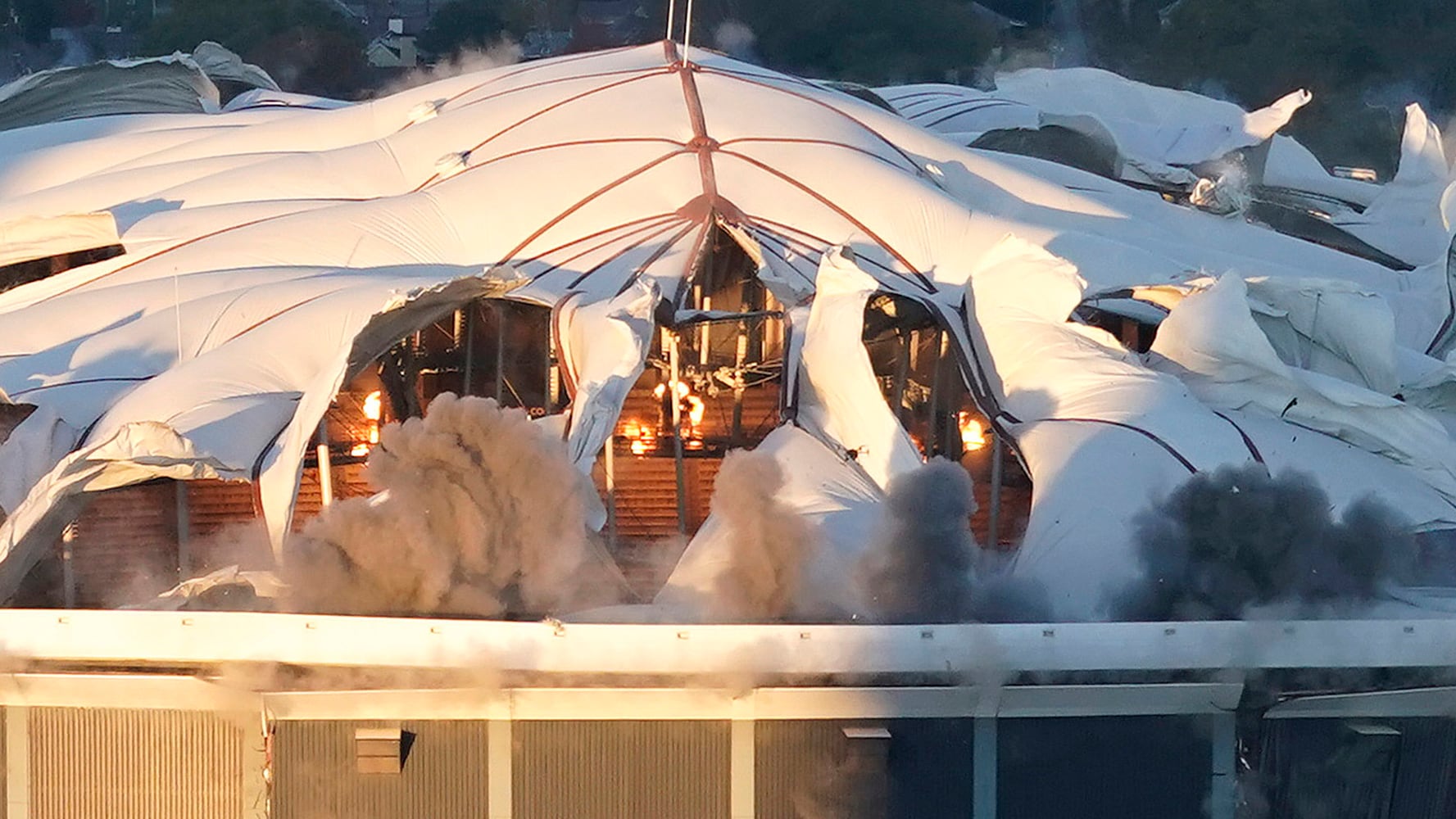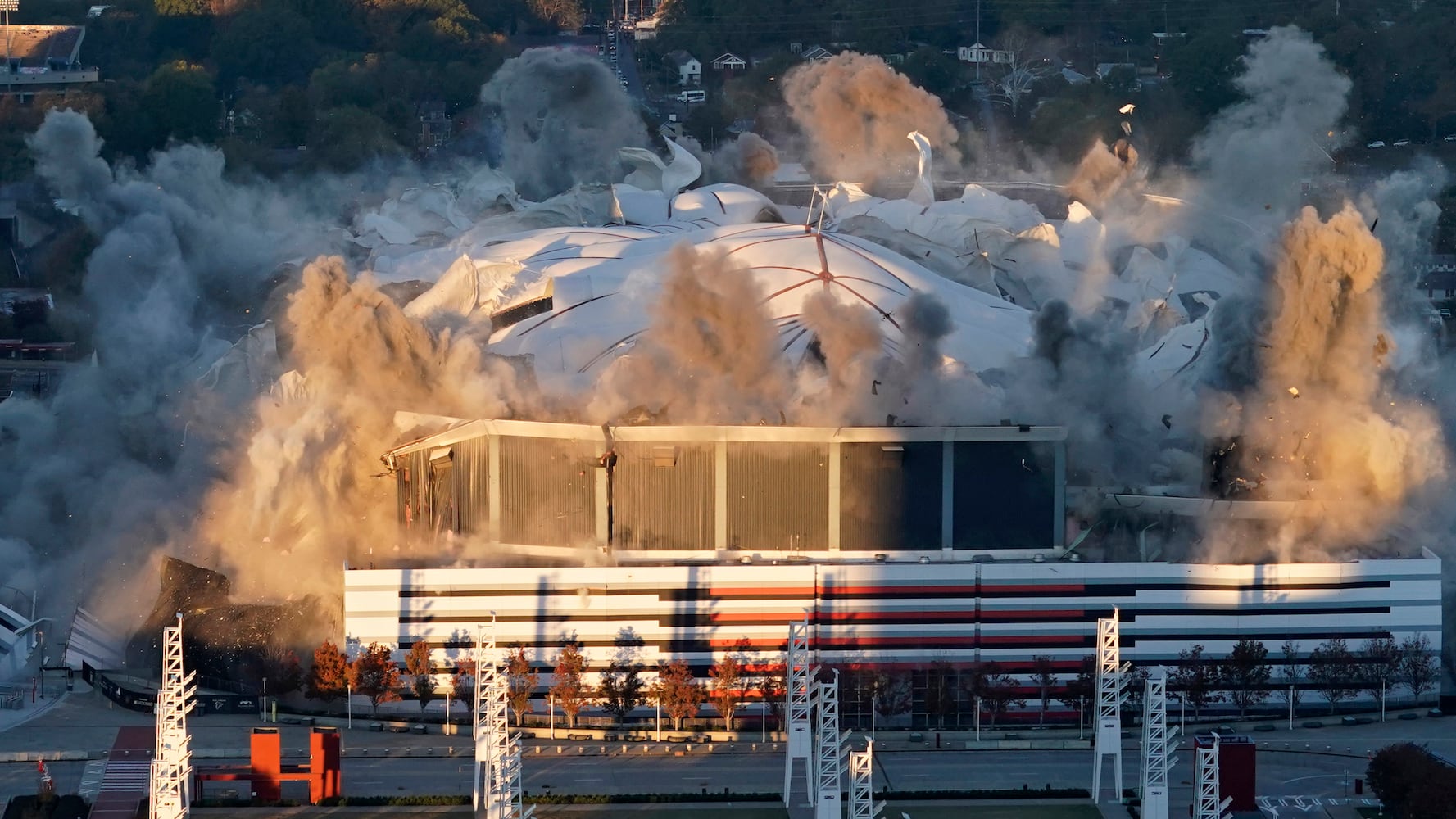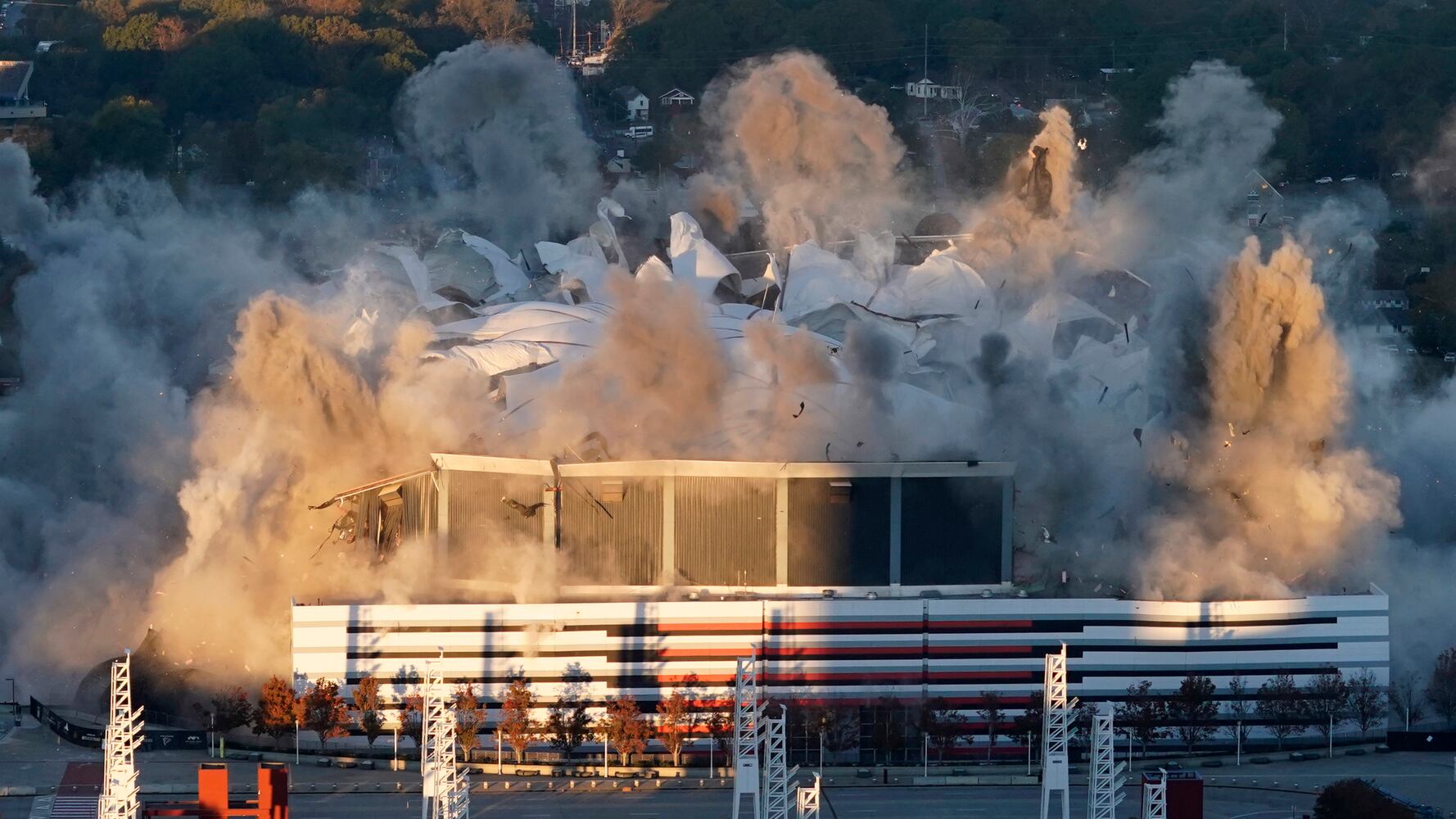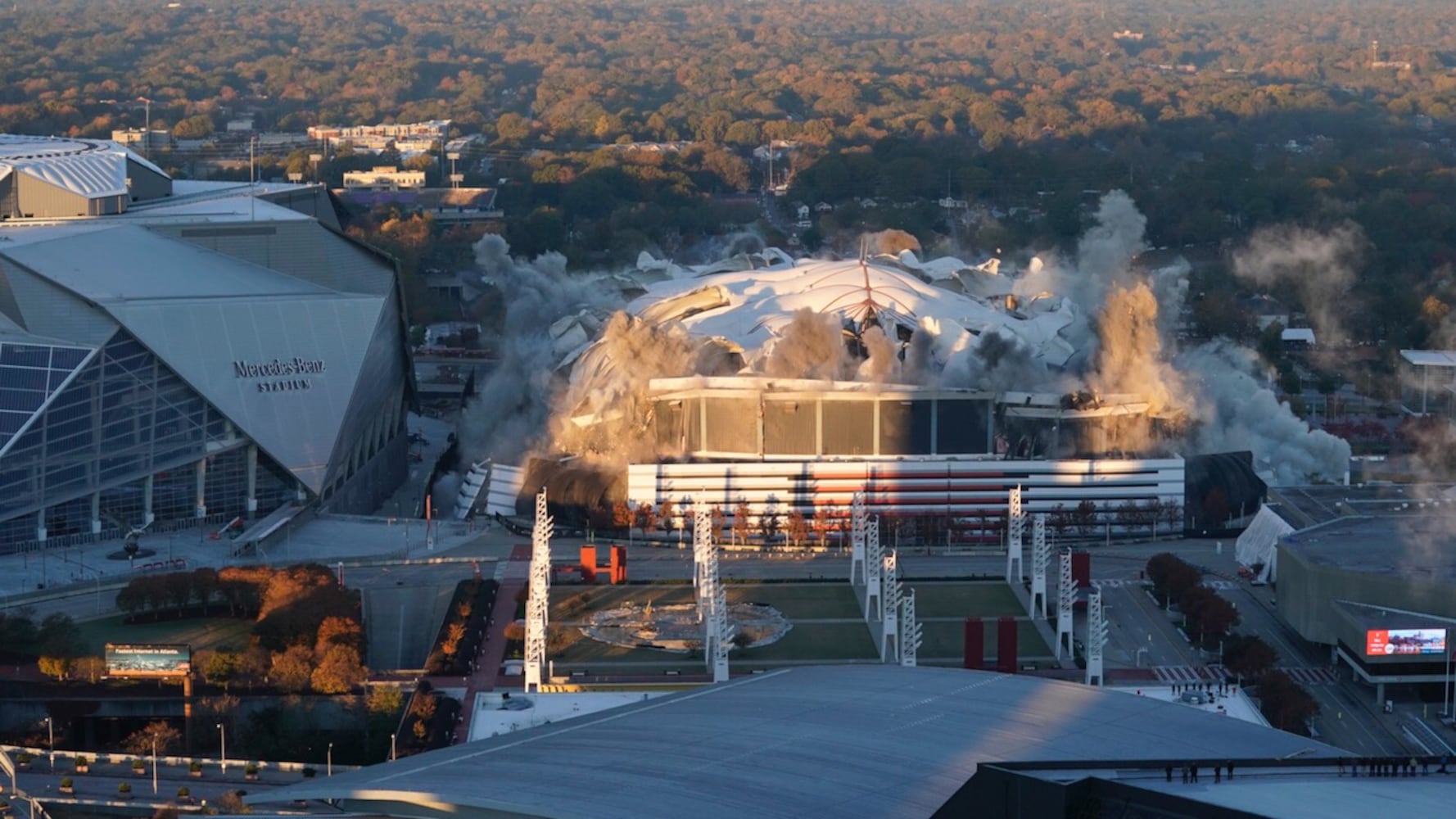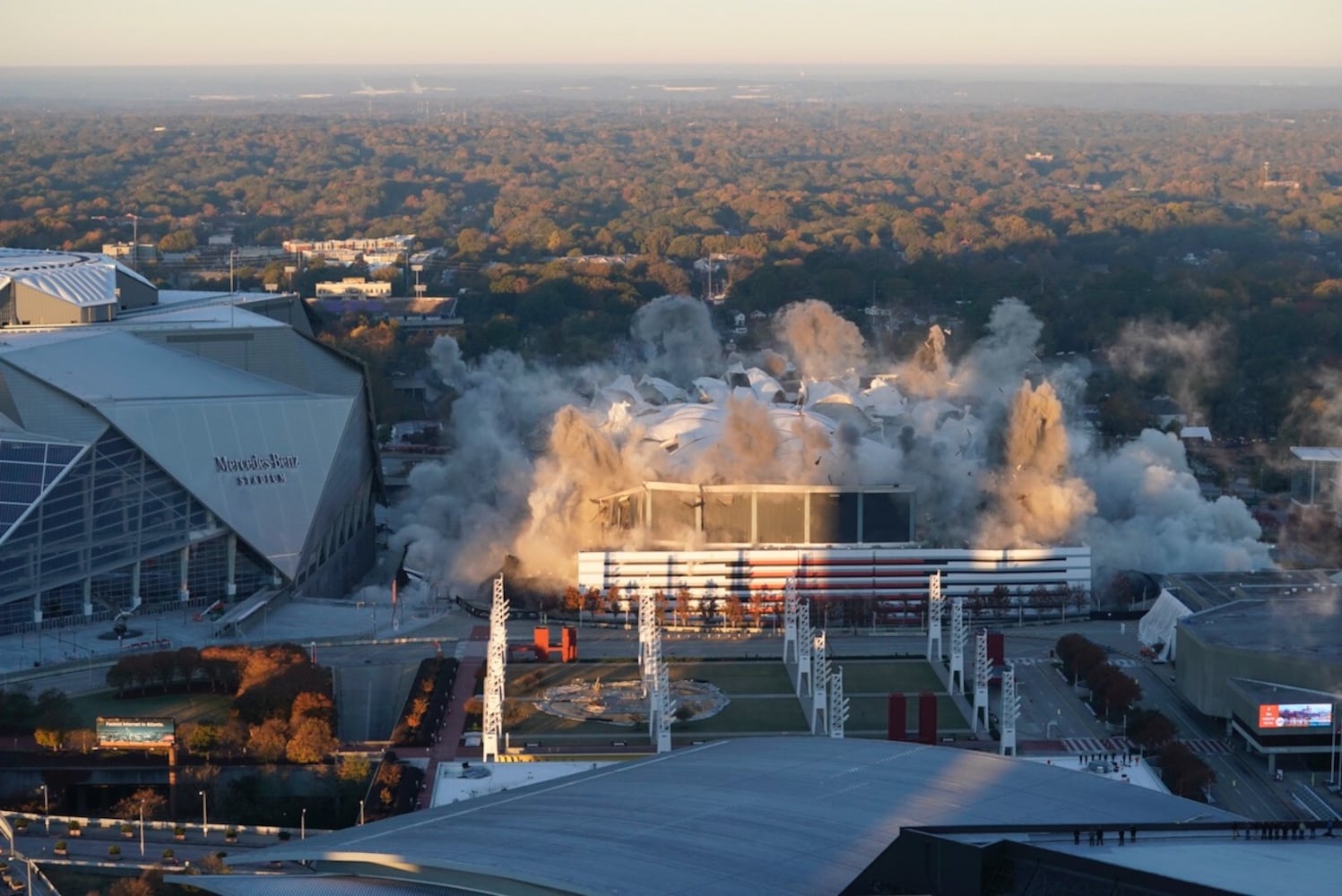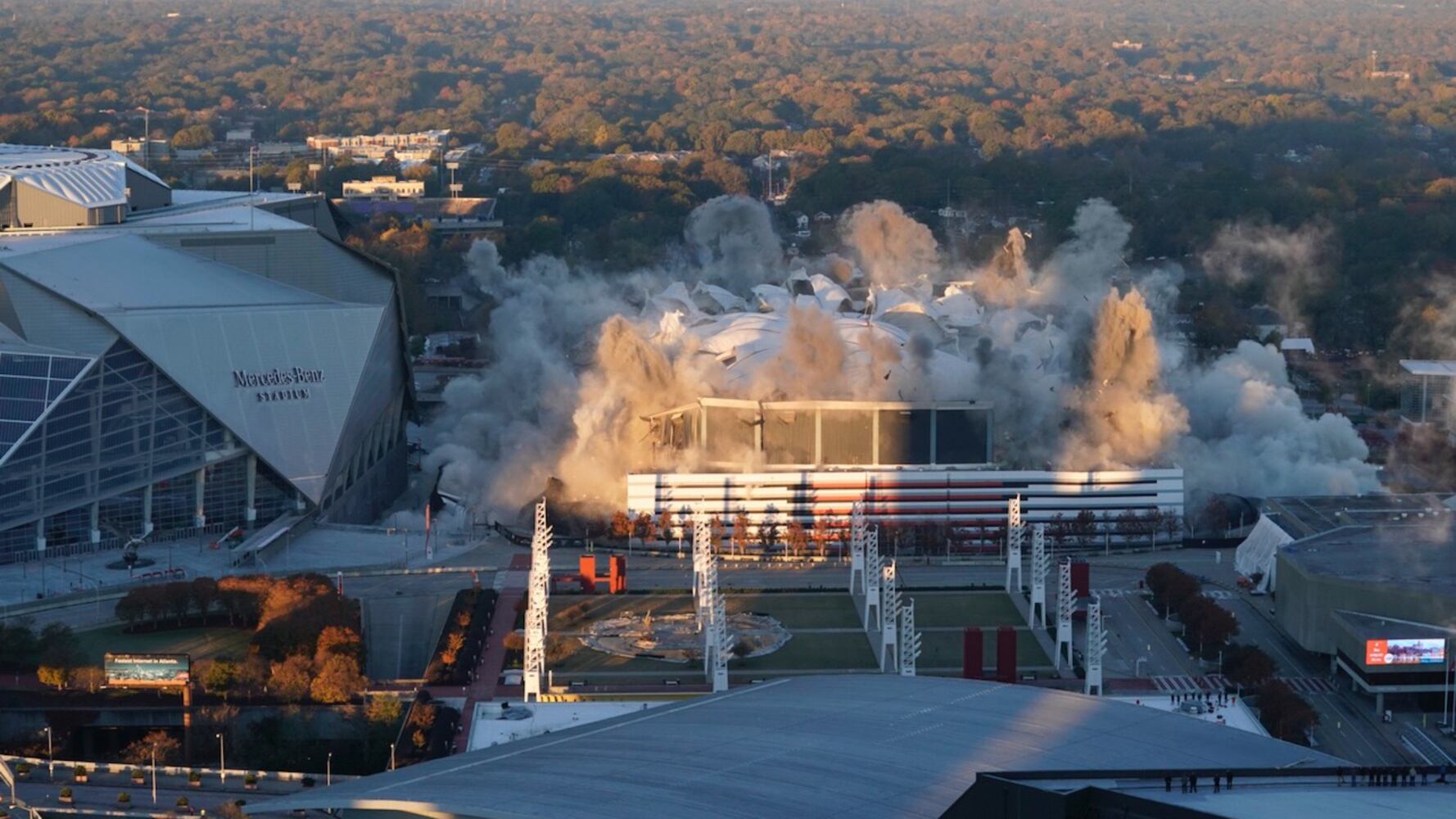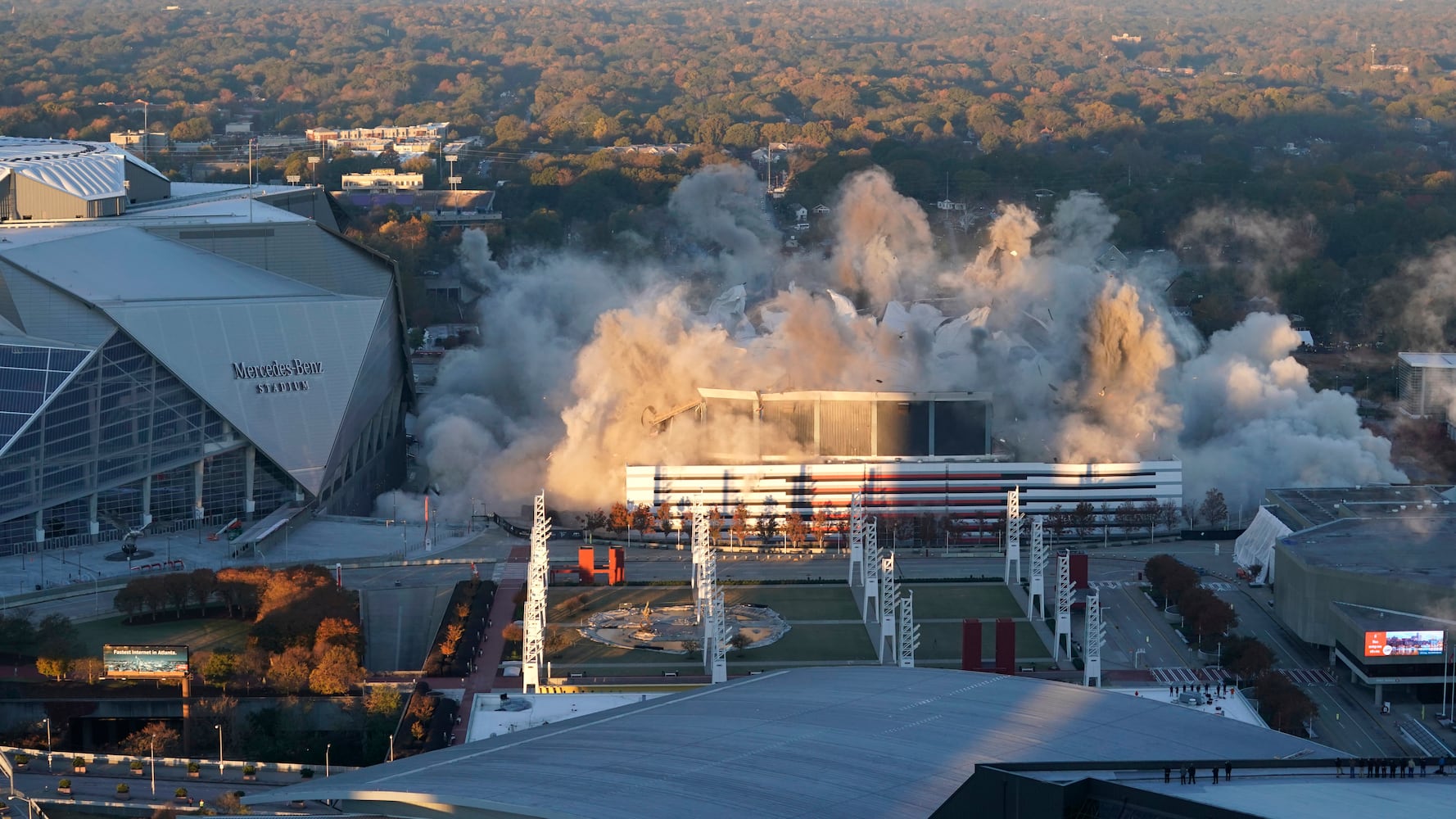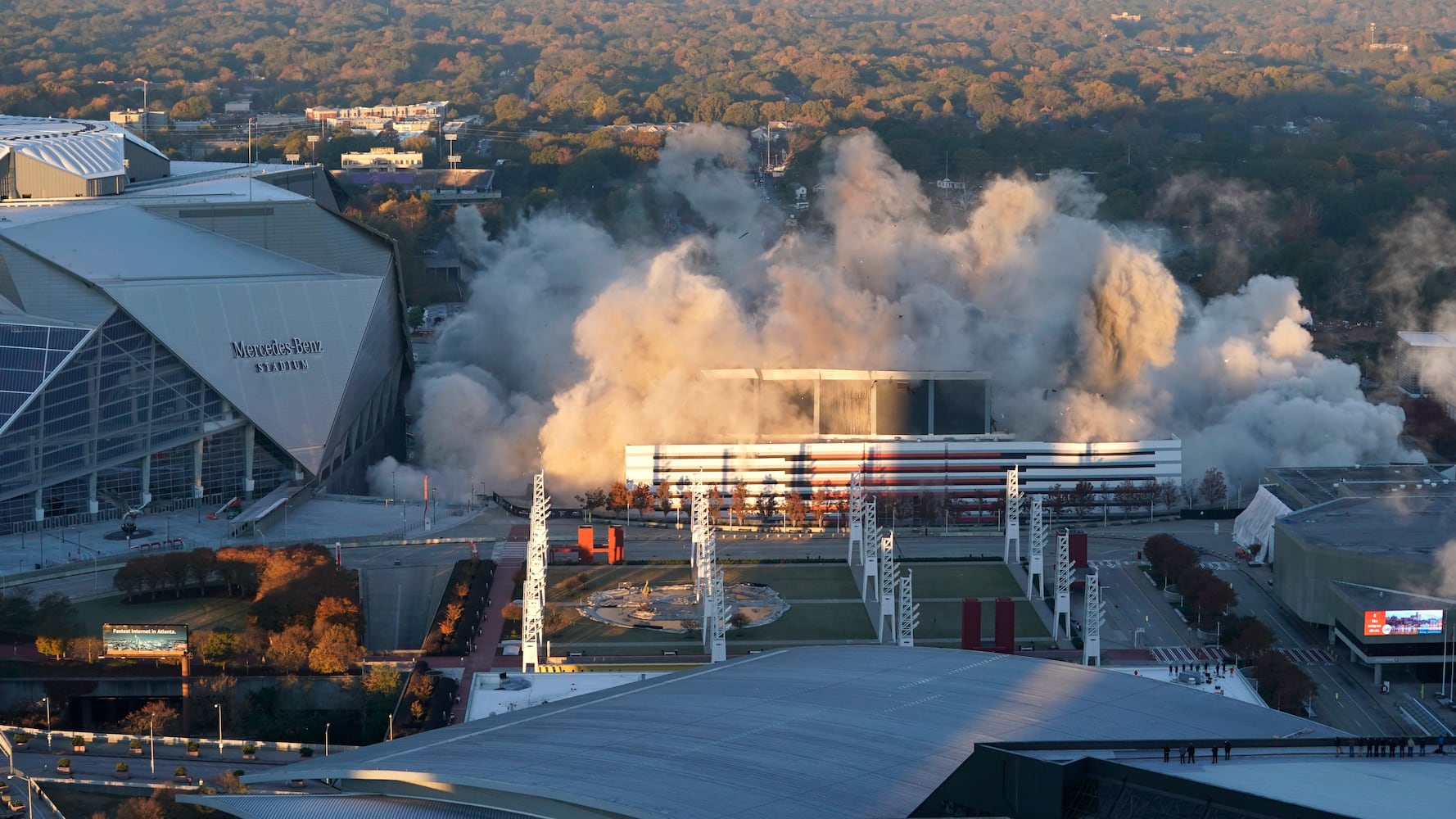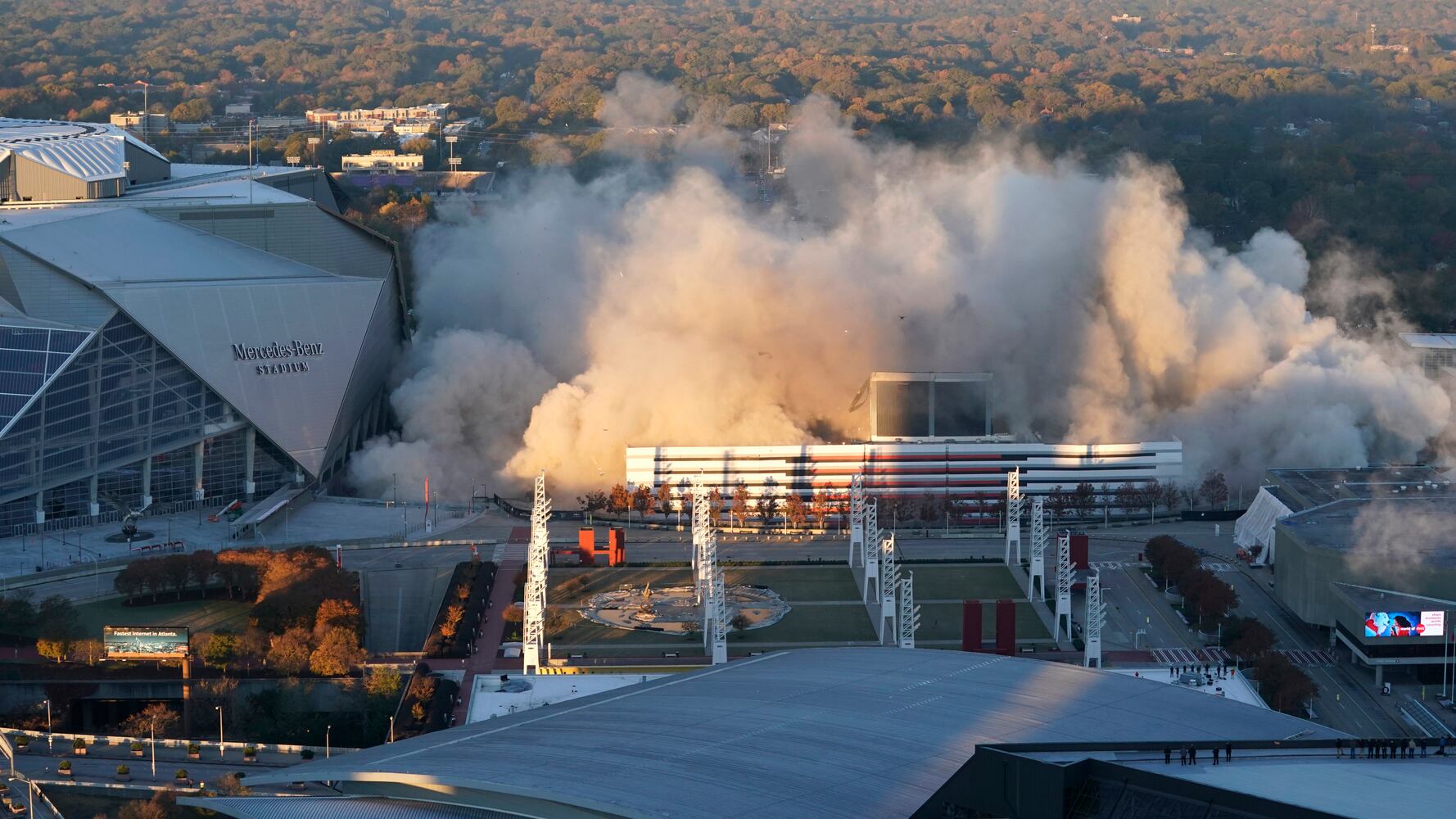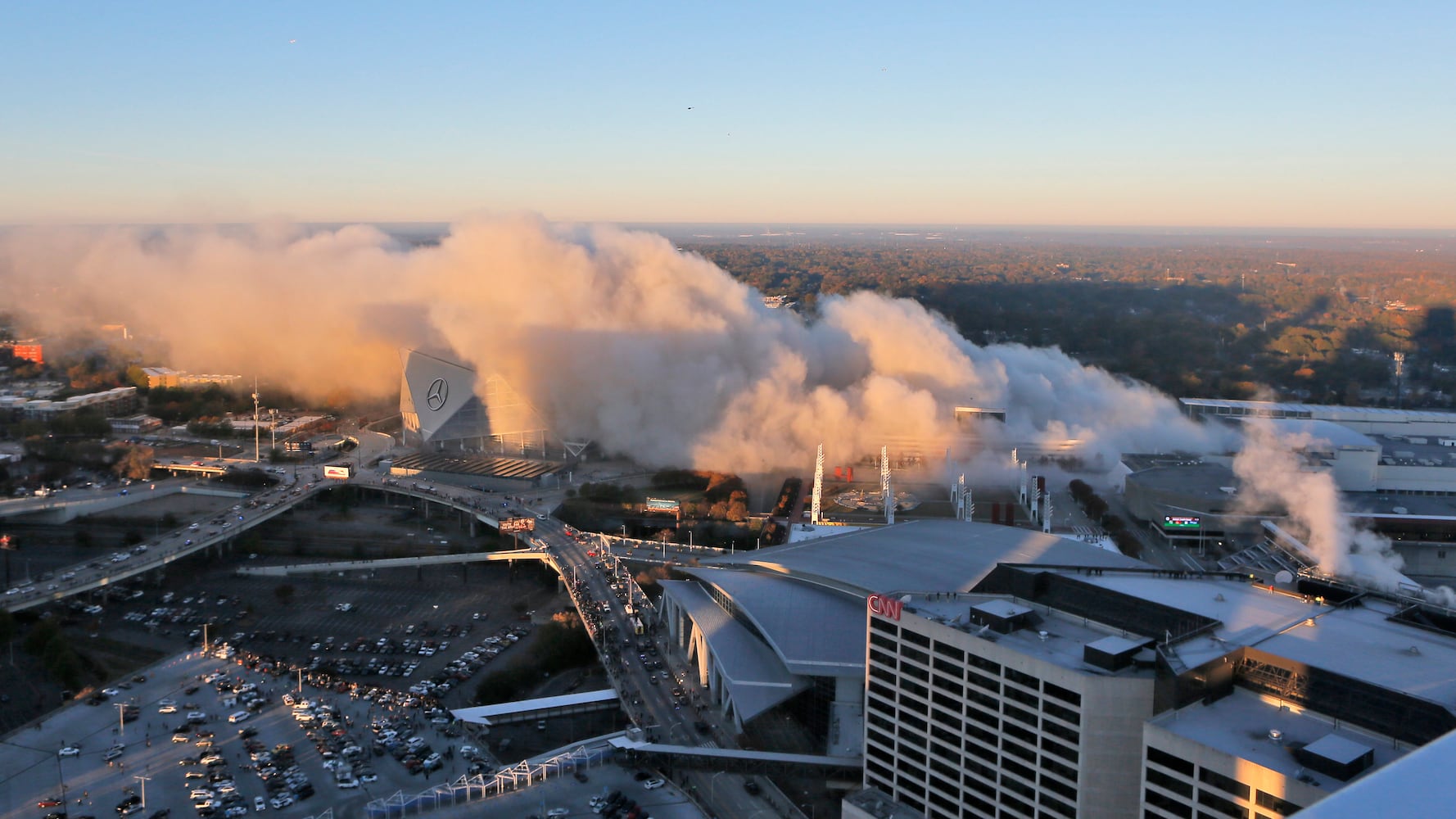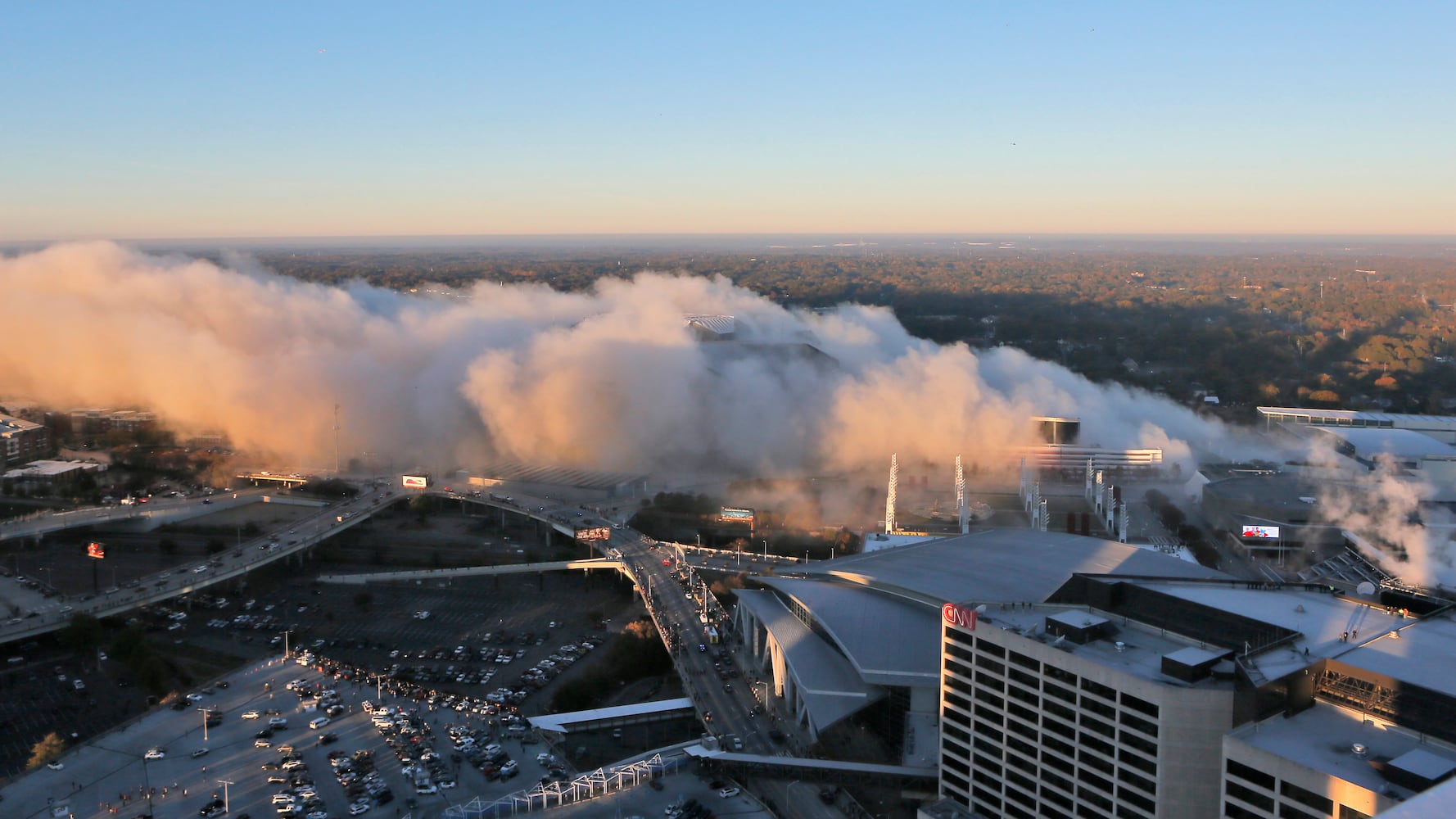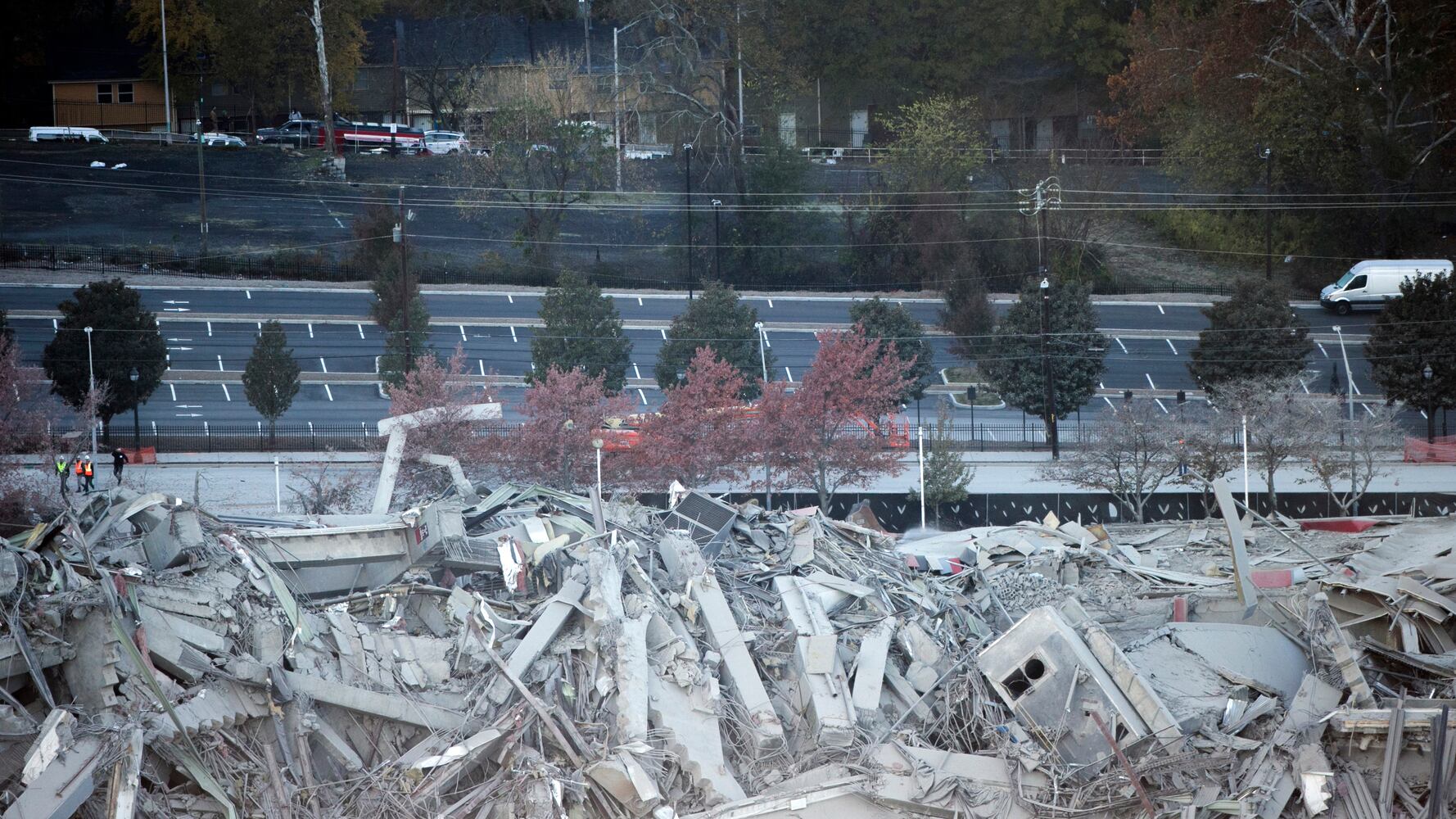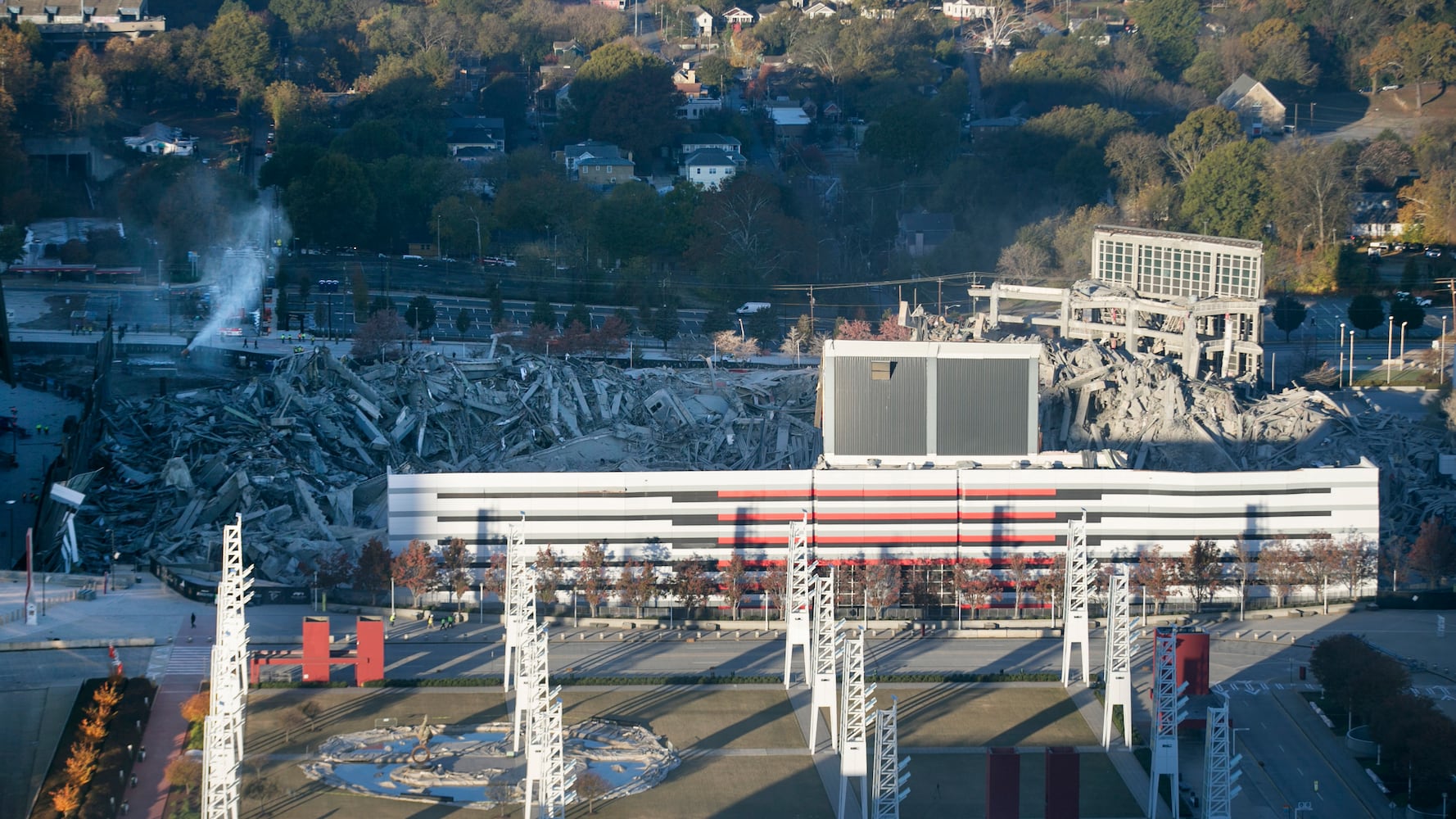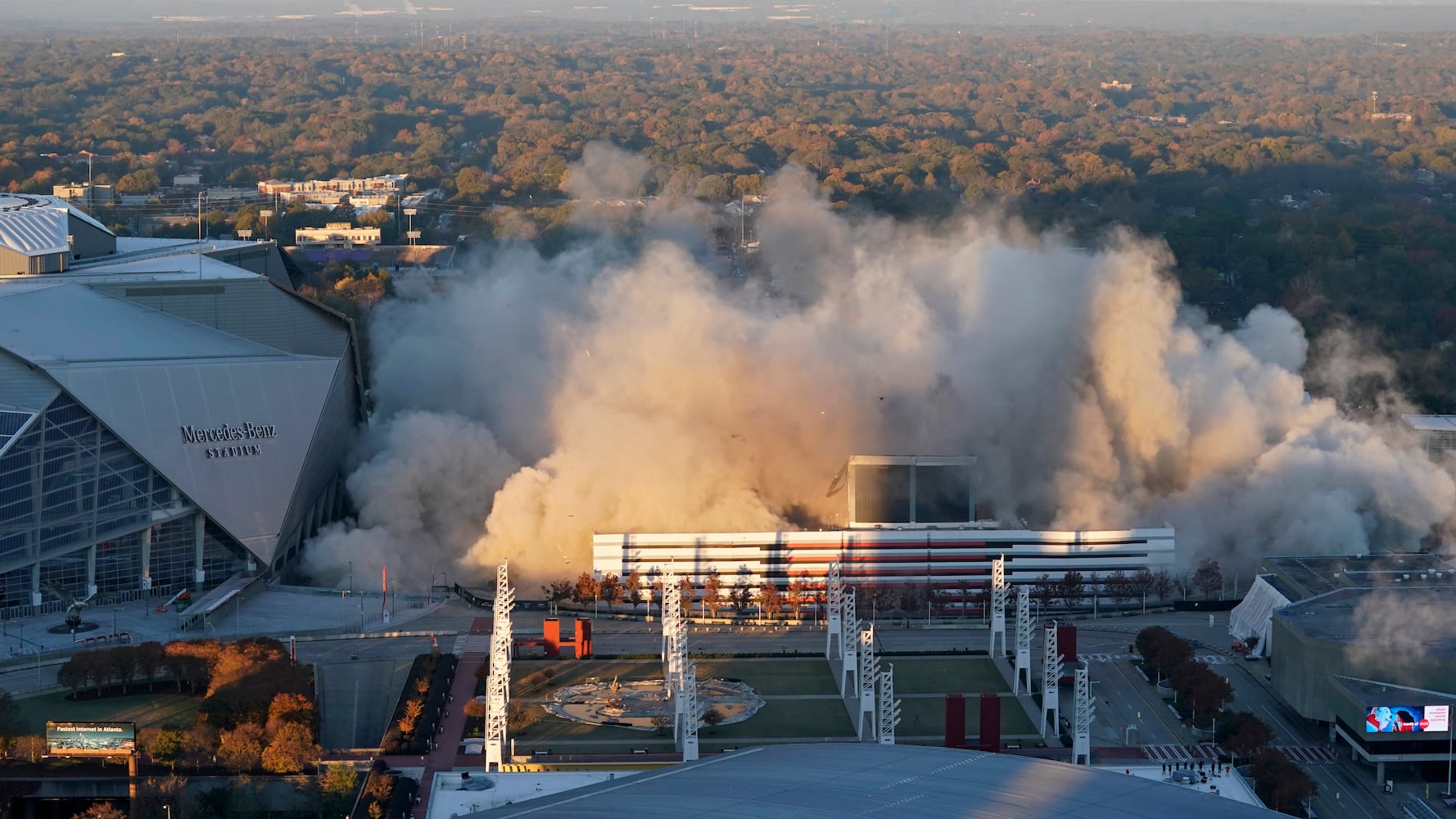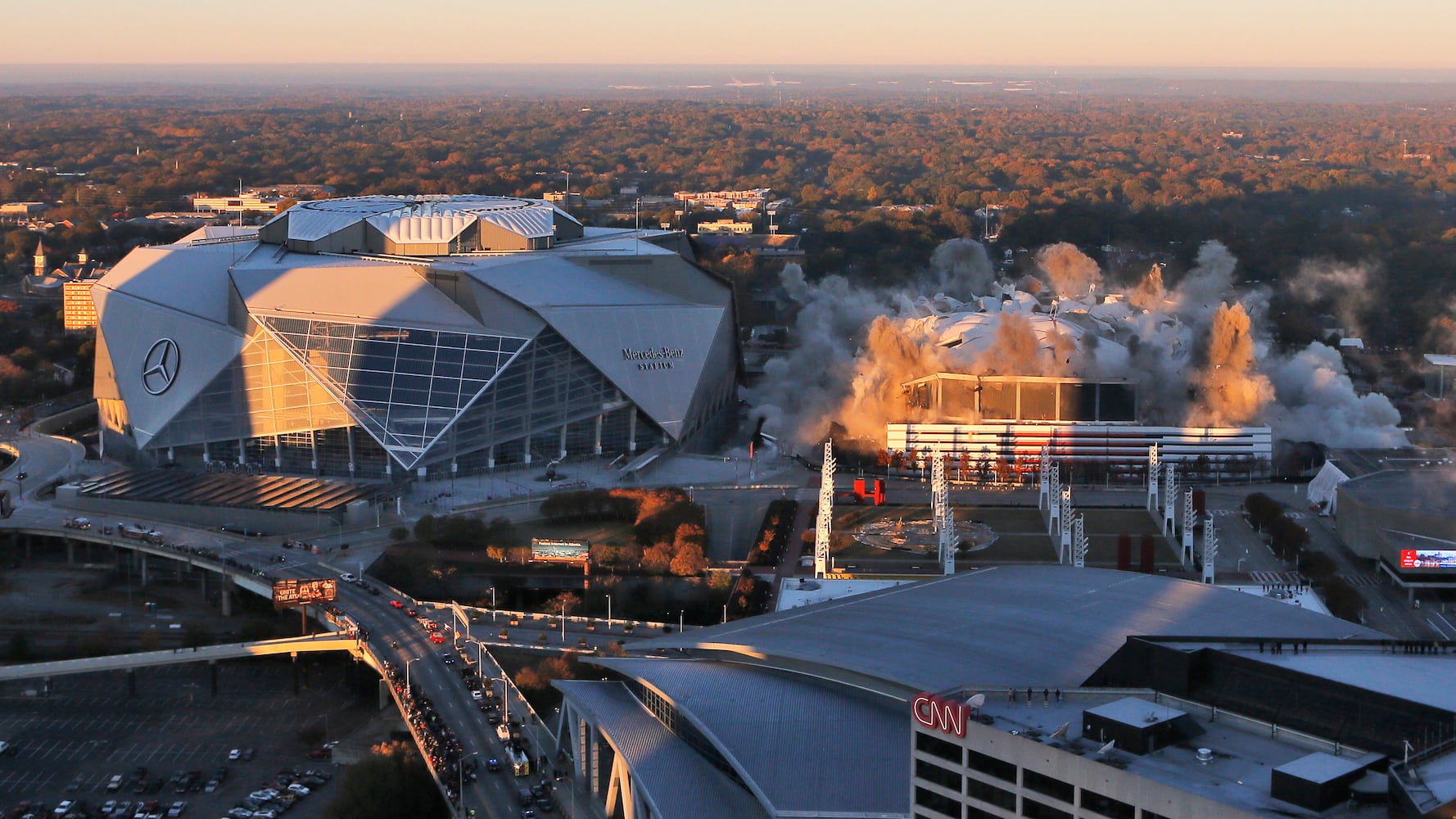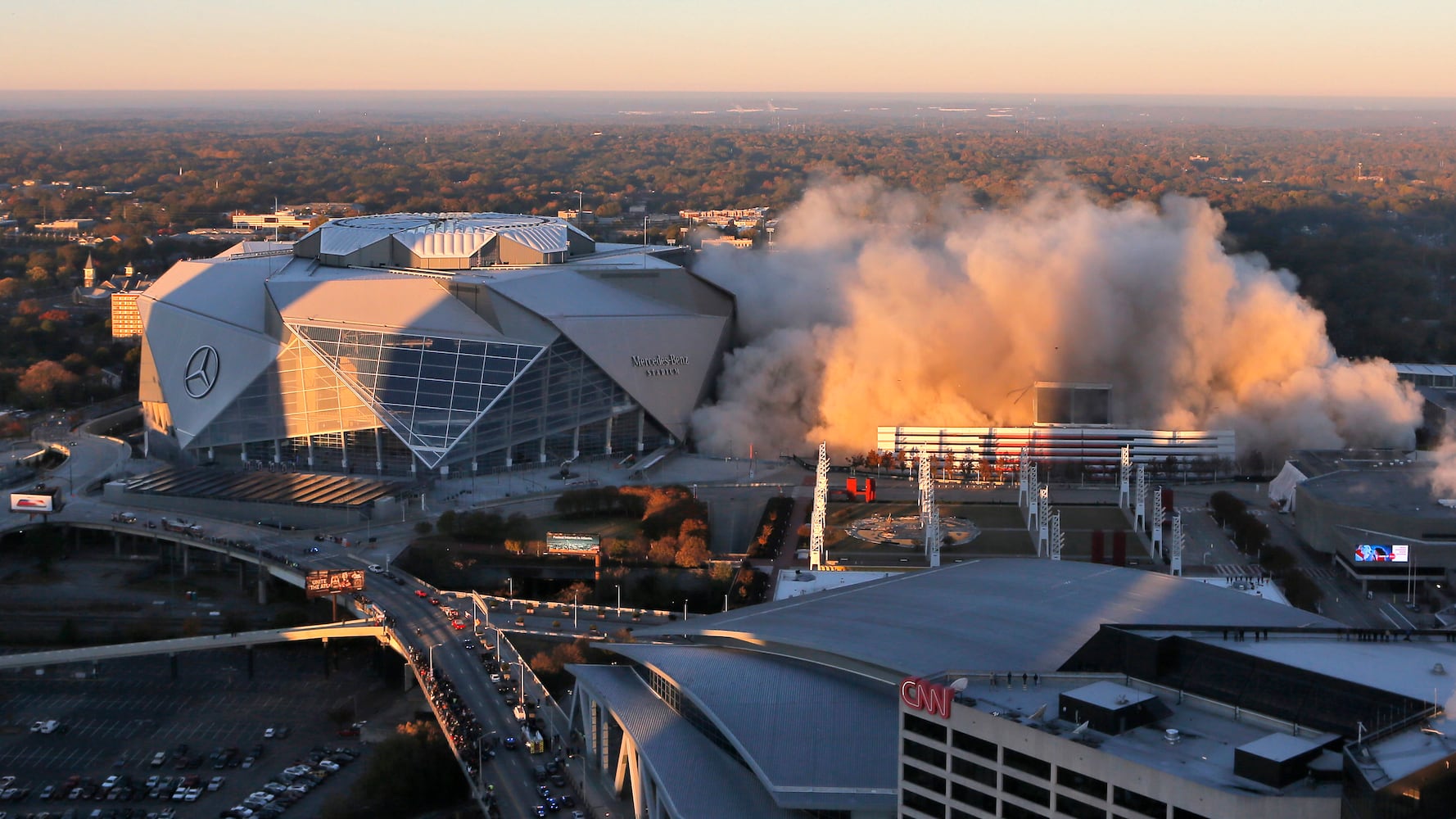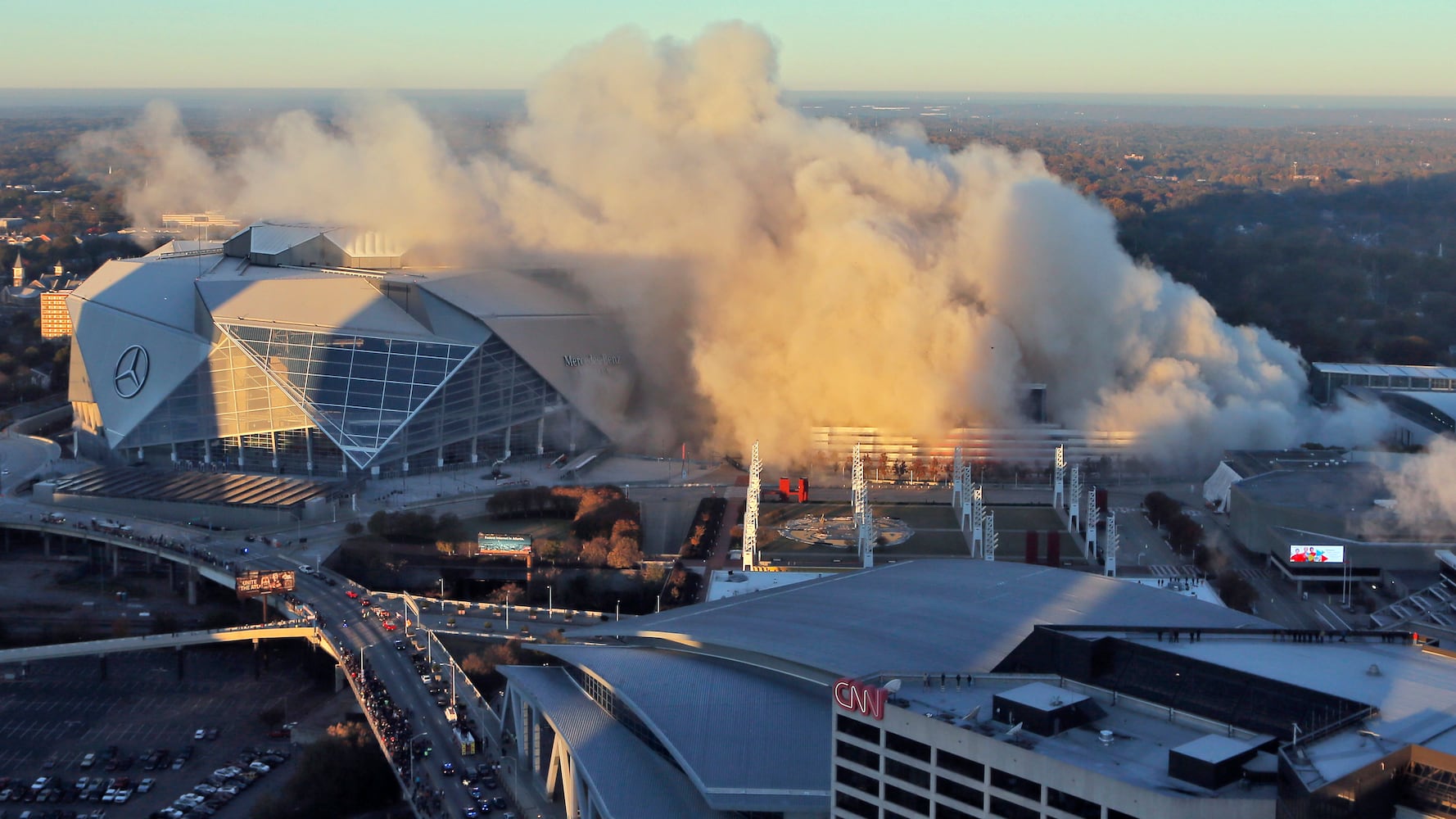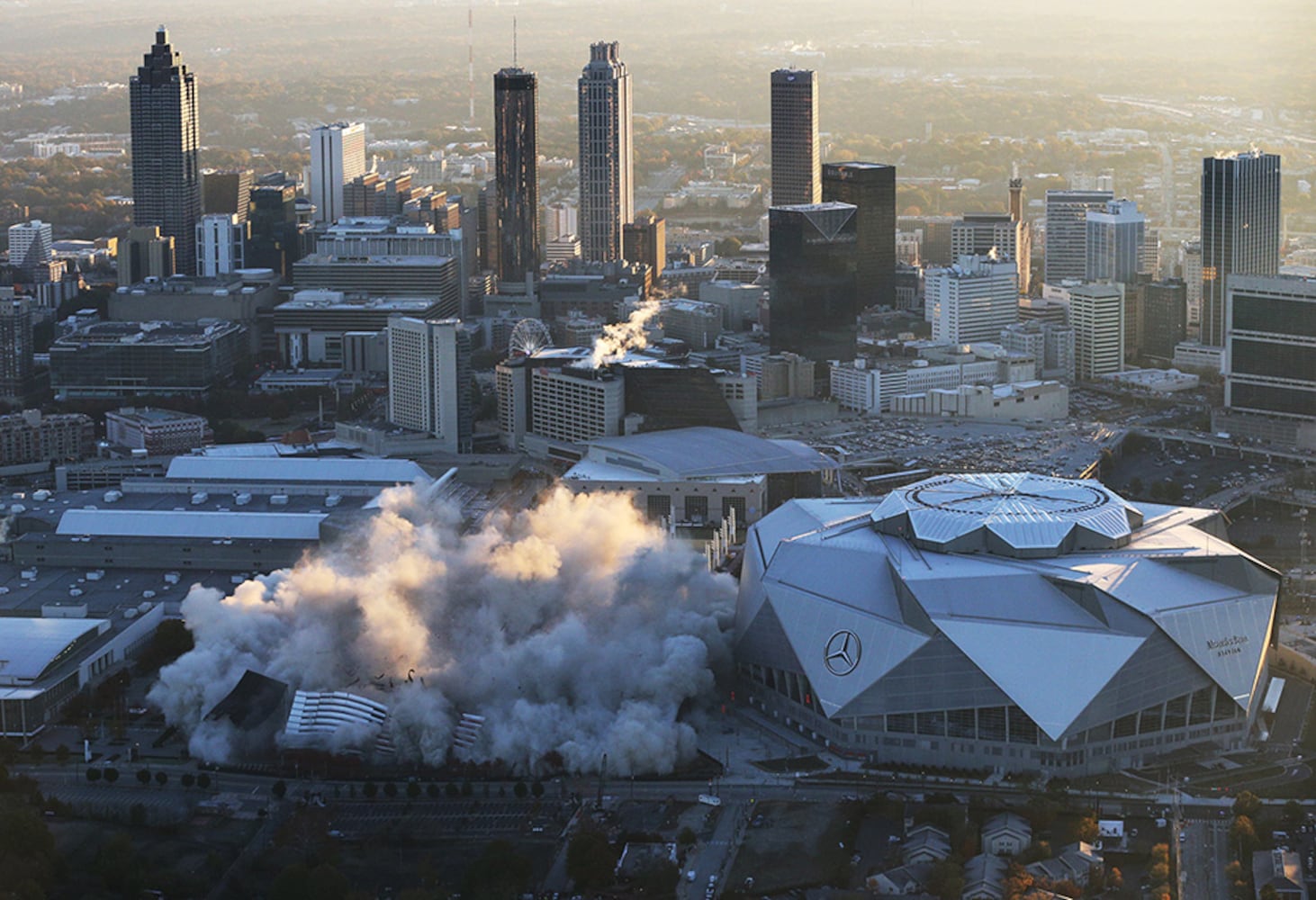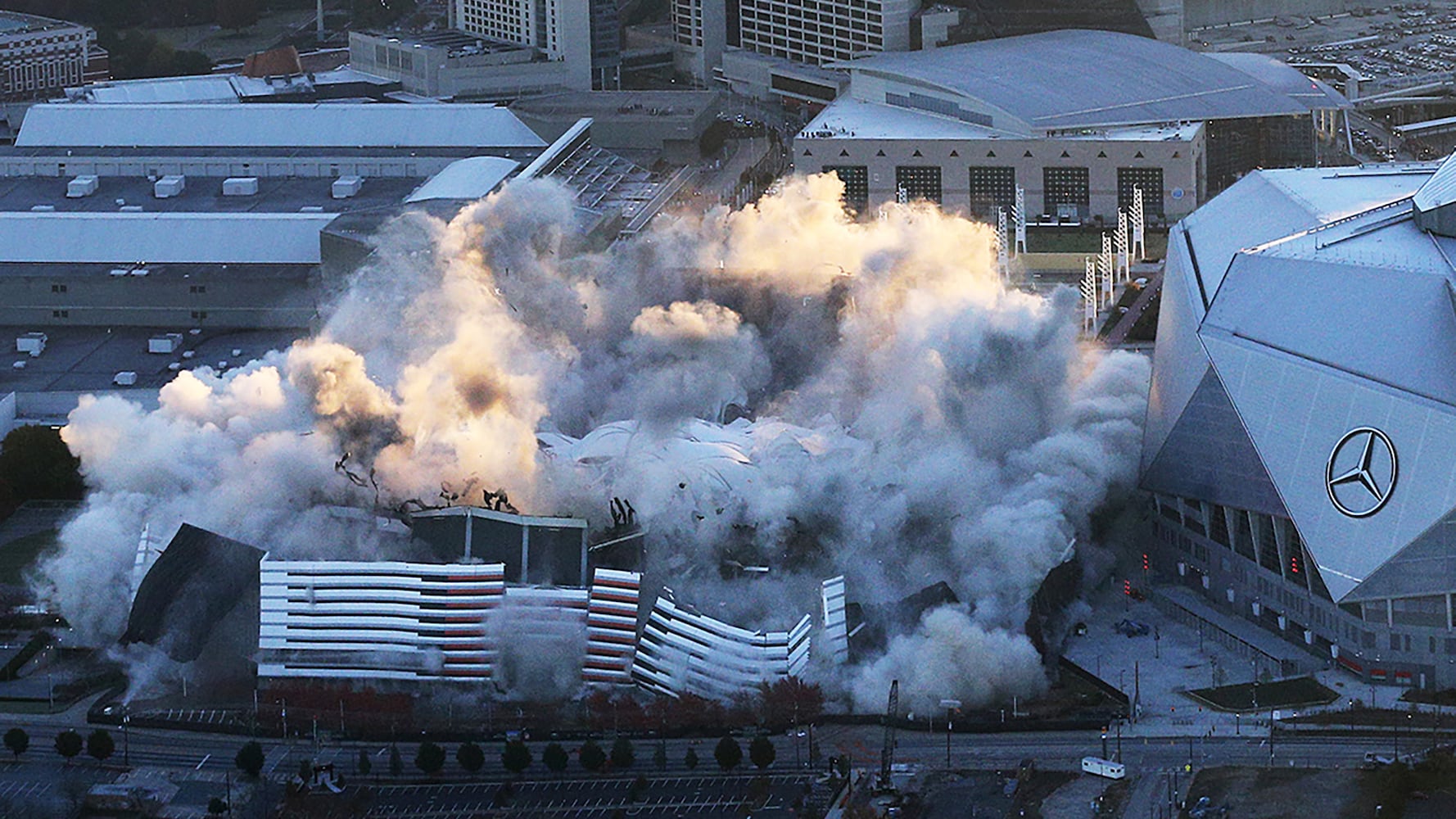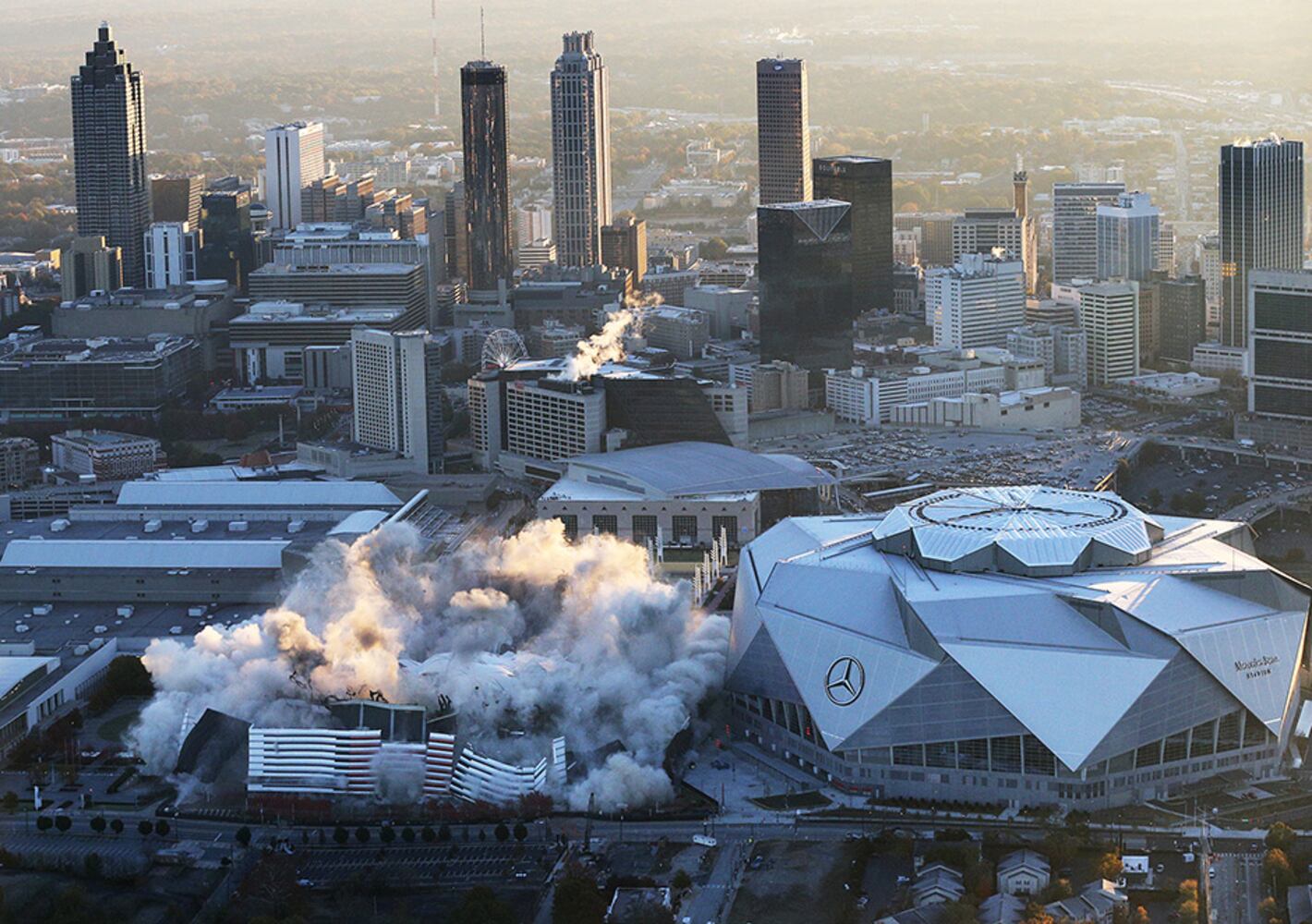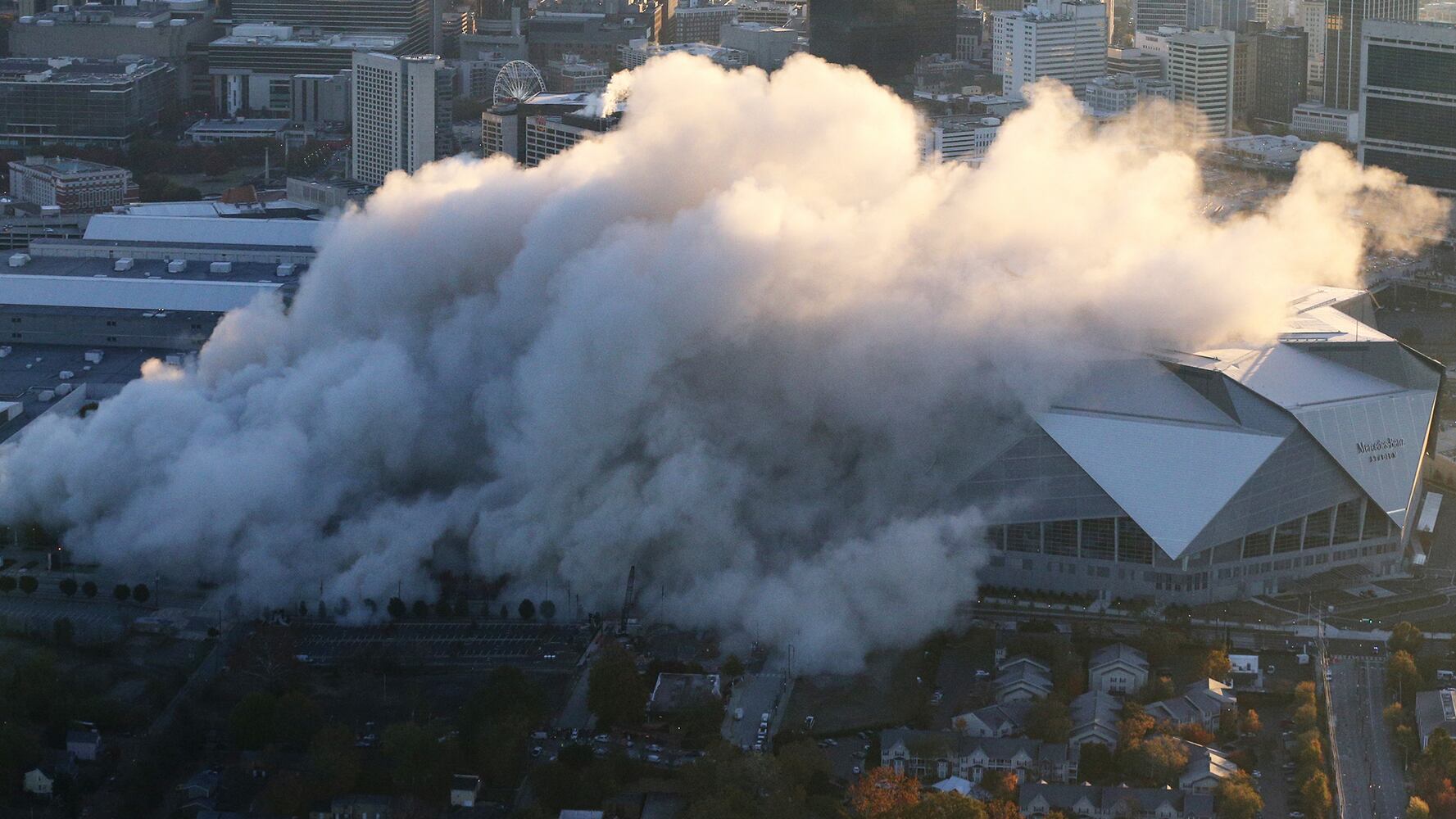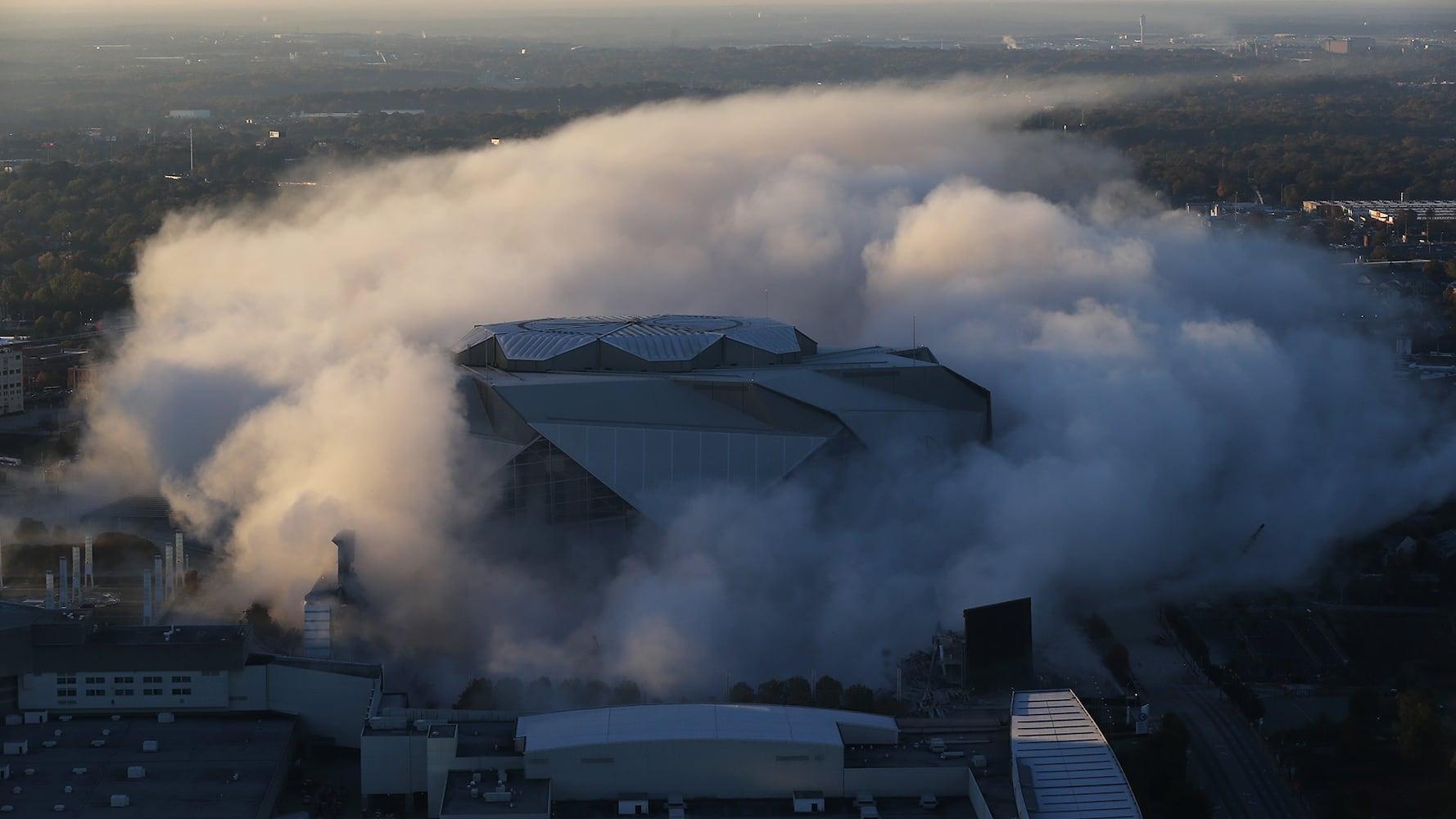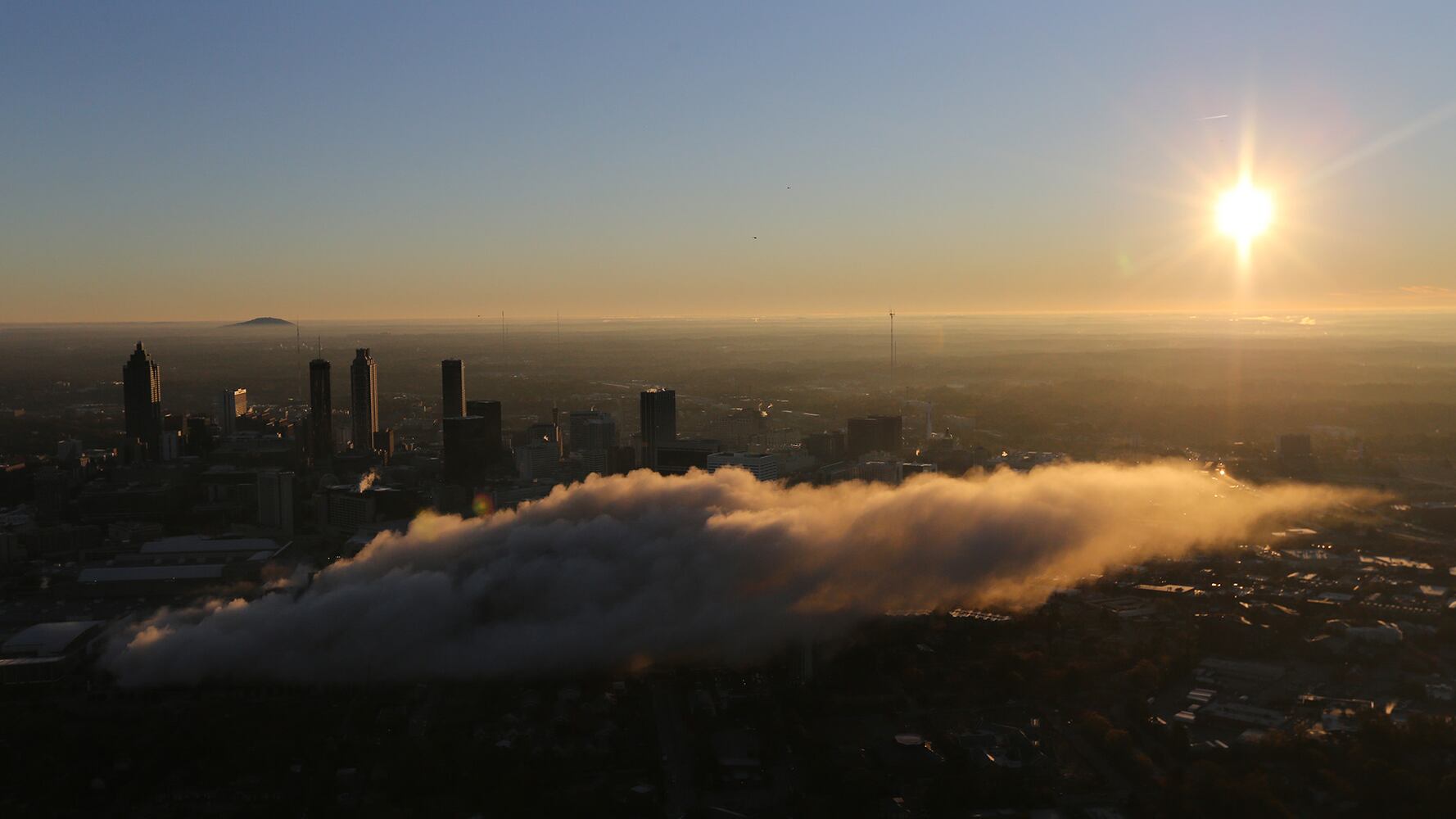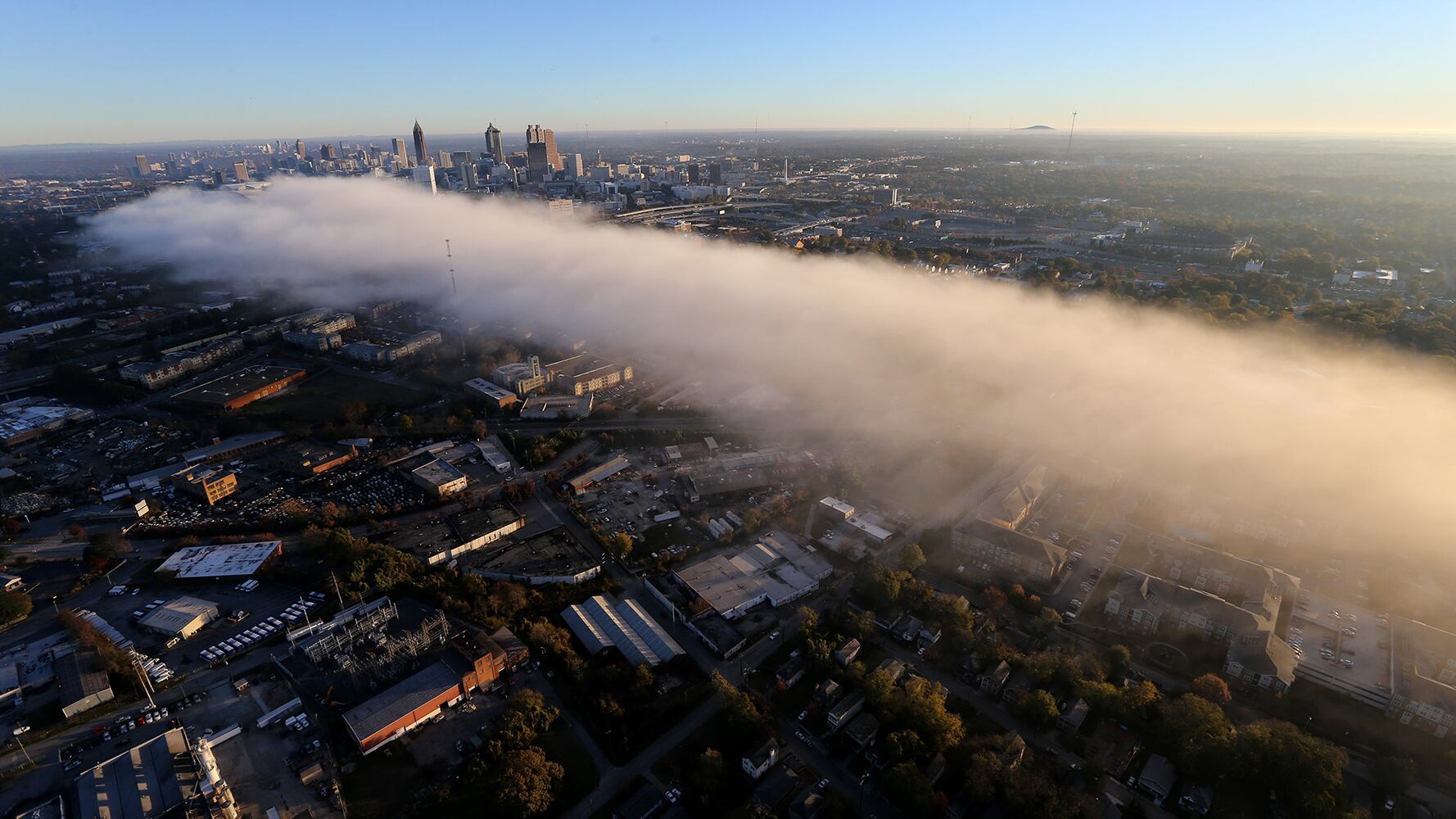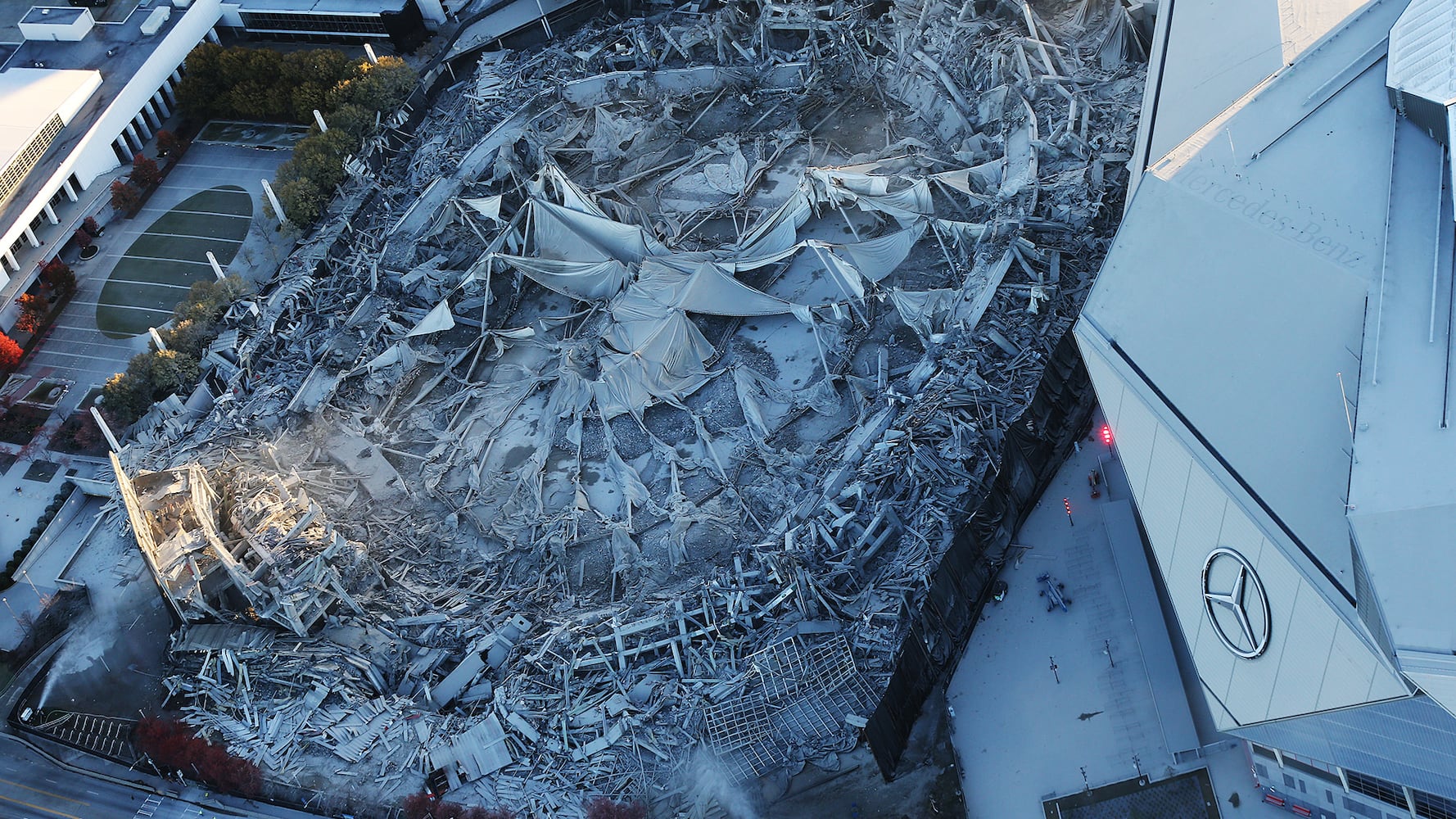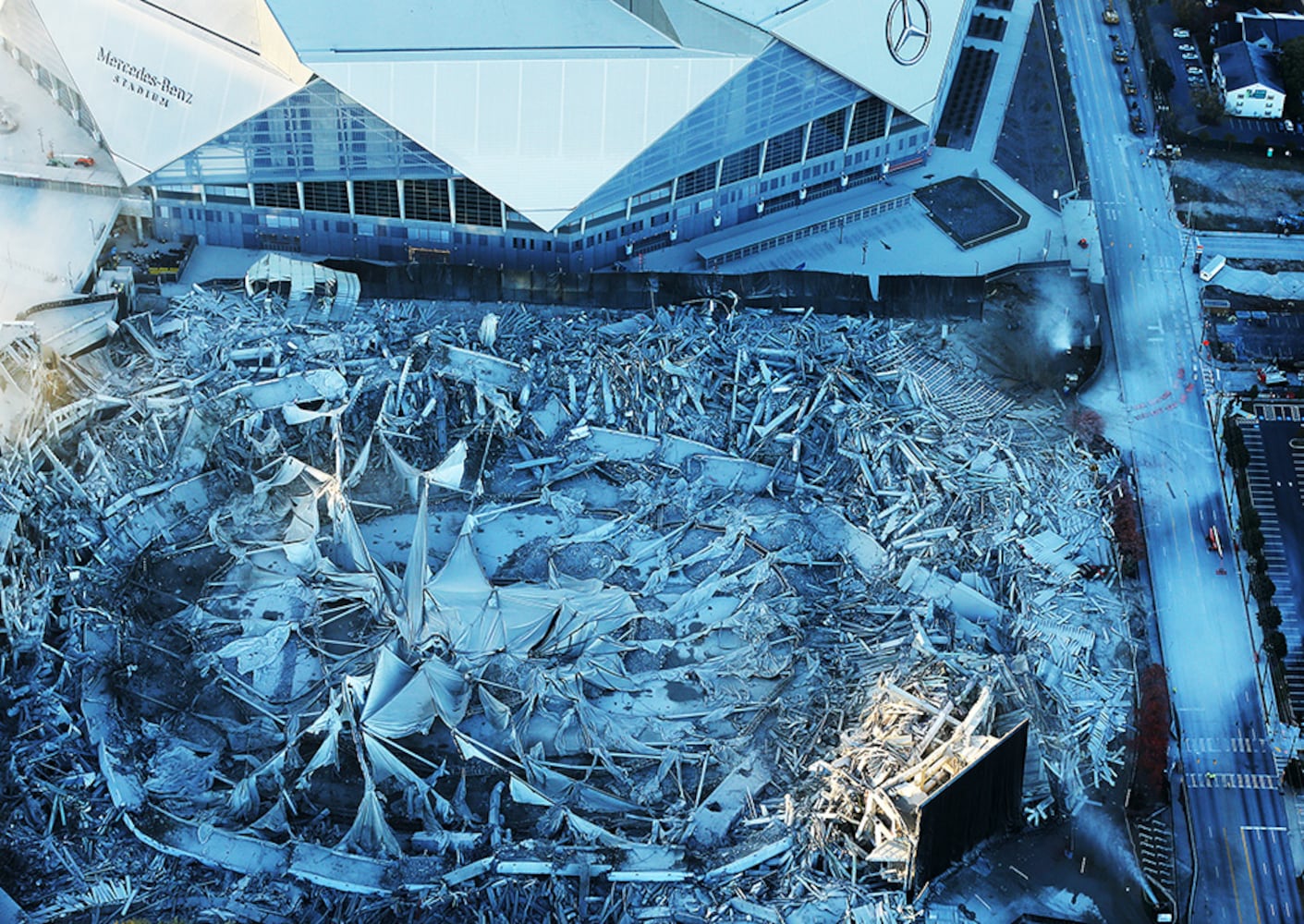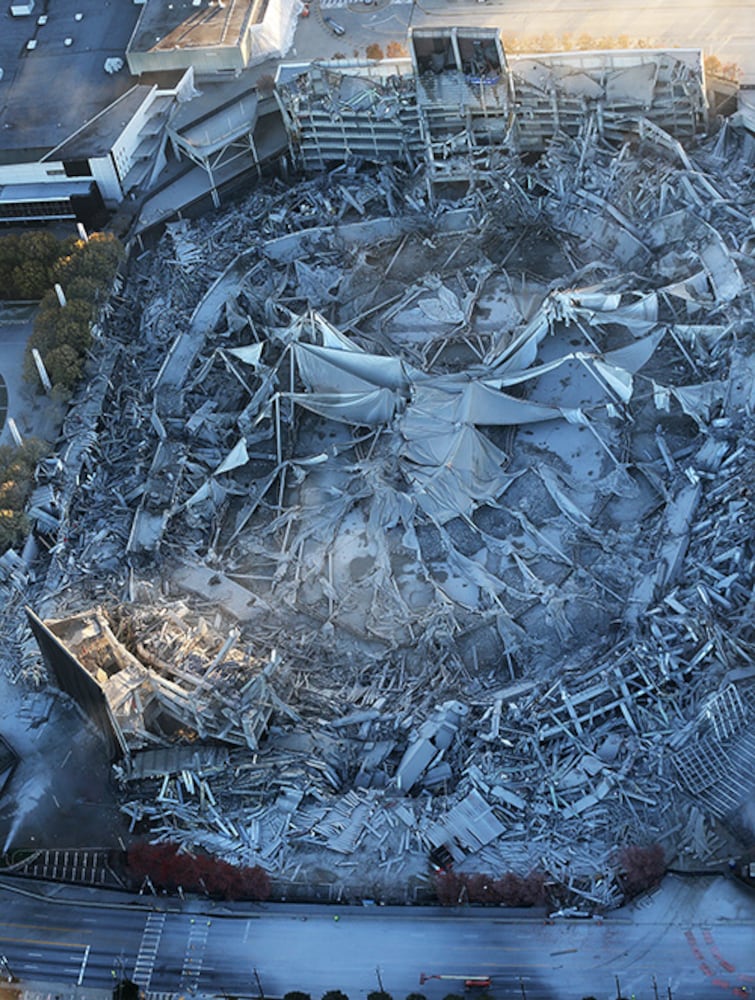Editor’s note: At a time when sports are shut down, we’re taking a look (in no particular order) at some of the bizarre moments from Georgia sports history.
A MARTA bus stops in front of a cameraman just as the Georgia Dome is about to come crumbling down, blocking The Weather Channel’s shot.
As the Dome implodes, a thick cloud of dust and smoke engulfs the sparkling new Mercedes-Benz Stadium next door, a parting shot from its doomed predecessor.
And then onlookers are surprised to see two large sections of the mostly imploded building still standing, stubbornly defying the dynamite.
Those are three enduring memories from the early morning of Nov. 20, 2017, when hundreds of people gathered nearby to watch 4,800 pounds of explosives bring down a 25-year-old stadium that hosted two Super Bowls, three men’s Final Fours, part of the 1996 Olympics, 256 Falcons games, 23 SEC Championship football games and many other marquee events.
“My eyes welled up as I was thinking about all the incredible events and the great times we had there,” recalled Carl Adkins, the Georgia Dome’s general manager for 14 years and its assistant GM for seven years before that. “It was a little difficult to watch her come down.”
But the MARTA bus, the parting shot of dust and the portions of the building that refused to fall brought laughter and levity – and maybe a bit of symbolism -- to the implosion occasion.
“The bus was certainly a good humorous moment,” Adkins said in an interview this month. “And the entire dust cloud going directly south and completely enveloping the new stadium – I thought that was kind of interesting at the time.”
As for the two substantial portions of the Georgia Dome that remained standing that day -- a long wall on one end and a structure around Gate B on an opposite corner -- Adkins put it best with a proud smile at the time: “I think she might have been a little sturdier than what they gave her credit for.”
Or as the first sentence in the AJC’s front-page story read: “The Georgia Dome didn’t go down without a fight.”
Credit: ccompton@ajc.com
Credit: ccompton@ajc.com
We’ll get back to all of that in a moment. But first, a bit of the backstory:
In August 1992, the Georgia Dome opened, an architectural marvel at the time. In early 2002, Arthur Blank bought the Falcons. In 2006, he said a new stadium would be needed in another decade or so.
By 2010, the Falcons and the Georgia World Congress Center Authority – the state agency that operated the Dome – were pursuing what they called a two-stadium solution: building a new open-air downtown stadium for the Falcons while keeping the Dome in operation for events that required an indoor venue. By 2012, the Falcons and the GWCCA concluded the two-stadium idea was inefficient and impractical.
A new retractable-roof stadium would replace the Georgia Dome, which would be demolished, they decided.
Construction on what would become Mercedes-Benz Stadium began in 2014 following long negotiations with the state, the city and two churches. After several construction delays related to the complicated roof, MBS opened in August 2017.
Which brings us, in much-abbreviated fashion, back to Nov. 20, 2017, three days before Thanksgiving.
By then, the Dome had been unceremoniously emptied and gutted -- seats and scoreboards removed, interior walls knocked down, glass removed, countless truckloads of debris hauled off. The 4,800 pounds of explosives had been placed in 3,500 strategically drilled holes and connected by seven miles of wire and cord, all calculated to bring down the stadium’s structural columns and roof ring beam in a precise series of blasts lasting a total of just 12 seconds.
There was little margin for error, considering the Dome’s close proximity to a new $1.5 billion stadium, the Georgia World Congress Center and a MARTA train tunnel.
At 7:30 a.m., following a dramatic 10-second countdown at a command center across Northside Drive, the president of lead demolition contractor Adamo Group pushed a button to set off the dynamite.
A quick series of explosions followed, separated by milli-seconds. The roof collapsed on cue, and most of the rest of the building crumbled within its footprint, leaving behind a mountain of smoking rubble, a quarter-century of memories and a legacy of helping make Atlanta a renowned host of major sports events.
The implosion was a sight to behold, but Jason Rudge, a cameraman for The Weather Channel, could see little of it.
Just as the first explosion went off, a MARTA bus rolled to a shot-blocking stop directly in front of him.
“No, bus!” Rudge yelled amid the sound of larger explosions. “Get out of the way! Bus! Get out of the way, bus! … What the (expletive)!”
When the implosion was completed, the bus moved on. And the ultimate photobomb immediately went viral.
The Weather Channel good-naturedly posted its bus-blocked video on YouTube, where it was viewed more than 1.4 million times. Sports Illustrated’s website had some fun with it, posting illustrations of the bus blocking various big sports moments. After a loss at San Antonio that night, the Hawks posted on social media an image of a MARTA bus blocking the final score. And Stephen Colbert opened his late-night TV show with some jokes and jabs about the incident.
There’s no shortage of videos of the implosion, though, as others were watching and filming from vantage points fortunately not blocked by a bus. From a viewing platform 2,500 feet away, long-time Georgia Dome employees fought back tears, some of them unsuccessfully.
“It seemed kind of surreal,” Adkins recalled this month. “It was great seeing a lot of people we had worked with over the years who came out to watch the implosion. But it still just seemed premature to me to be taking the building down, given all the great events we did there. But it was inevitable at that point.”
Credit: Curtis Compton
Credit: Curtis Compton
When the thick cloud of dust and smoke began to clear, the spectators did a double-take at the unexpected sight of the two still-standing portions of the Georgia Dome.
The demolition contractors insisted it wasn’t unusual for a small percentage of a building to remain intact after an implosion and declared the day a success. They later said the two portions survived because “some of the charges did not go off.” But some Dome loyalists always will see it as their beloved building’s final show of strength.
“It just seemed fitting,” Adkins said this month, “that the building was kind of stubbornly saying, ‘I’m not done yet.’”
The Georgia Dome’s official Twitter account made the same point shortly after the implosion, posting a photo of the still-standing wall and these words: “Y’all thought it would be easy just to get rid of me? Nah.”
And then there was the heavy blast of dust that the Dome delivered to Mercedes-Benz Stadium, located just 83 feet to the south.
Credit: ccompton@ajc.com
Credit: ccompton@ajc.com
“The wind switched on us and went right there,” Rick Cuppetilli, executive vice president of the lead demolition contractor, said at the time. “We weren’t going to stop the implosion, so we’re going to work on cleanup efforts with them.”
No significant damage was done to the new stadium, a 50-foot-tall industrial-strength curtain having been hung to protect it from any flying debris. Just a nick in one door frame was reported. After some serious pressure-washing, MBS was all cleaned up again.
A month later, at 1 a.m. Dec. 20, 2017, a “supplemental implosion,” using about 300 pounds of explosives, brought down the long Georgia Dome wall that had survived the first attempt. Separately, the other remaining portion was taken down mechanically.
Most of the site has been converted to The Home Depot Backyard, a green space and premium tailgating area. A 1,000-room hotel is planned for another section of the site.
The Dome’s successor has delivered the big events it promised. Mercedes-Benz Stadium hosted the College Football Playoff Championship game in January 2018 and the Super Bowl in February 2019, and it would have hosted college basketball’s Final Four last month if not for the coronavirus pandemic.
A historical marker has been erected where the Georgia Dome stood for a quarter-century. It reads in part: “Completed in three years, the $214 million, 71,996-seat Georgia Dome opened in August 1992 as the world’s largest cable-supported domed stadium, serving as the home of the NFL’s Atlanta Falcons for 25 seasons. The stadium hosted some of the world’s most prestigious sporting and entertainment events, welcoming more than 37 million guests and generating an economic impact of 7 billion dollars. … The Dome was demolished on November 20, 2017.”
And quite a memorable demolition it was.
About the Author
Keep Reading
The Latest
Featured
